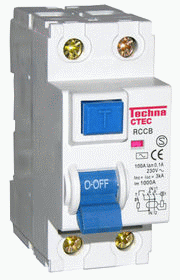

Residual Current Device |
|
To gain access to revision questions, please sign up and log in.
This behaves like a fuse but has additional useful safety features.

Under normal safe operating conditions, the current flowing into a circuit will be the same as the current flowing out of it. If this is not the case, current must be flowing somewhere else (for example through faulty insulation or even through a human who is being electrocuted).
RCD devices detect these current imbalances and turn off the circuit when an imbalance is detected. A typical imbalance is 5 milliamps. They also turn off the balanced circuit if the current exceeds a safe limit such as 30 Amps.
This works by making the current flow through two identical electromagnets which point in opposite directions. It the magnetic field in both magnets is the same, the fields cancel out. When there is a current imbalance, the magnetic effect does not cancel out and the device trips and turns off the circuit.
The device in the image above has a test button. When pressed, this deliberately unbalances the current and the device should trip. The RCD is reset by turning the toggle switch on.
Most domestic wiring is protected by RCD devices.
A less safe alternative is a fuse. This only protects against excessive currents.
RCD devices are sometimes tripped by sudden current pulses. These can be caused by lightning strikes.
reviseOmatic V3 Contacts, ©, Cookies, Data Protection and Disclaimers Hosted at linode.com, London